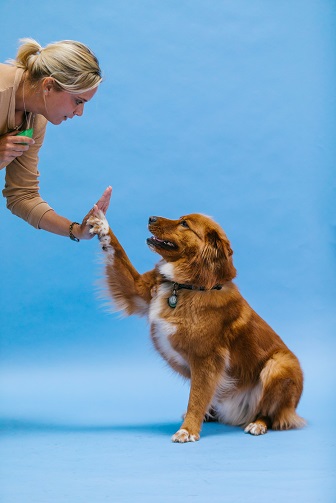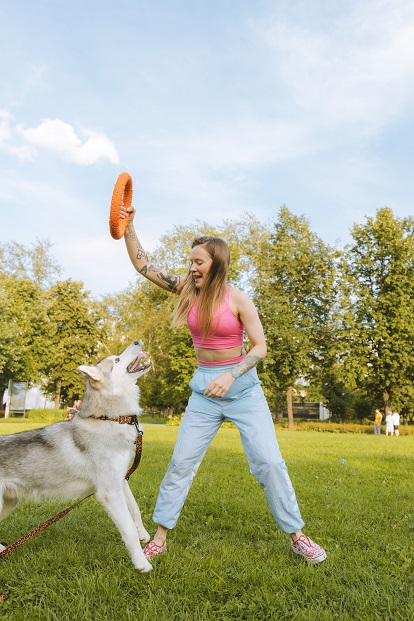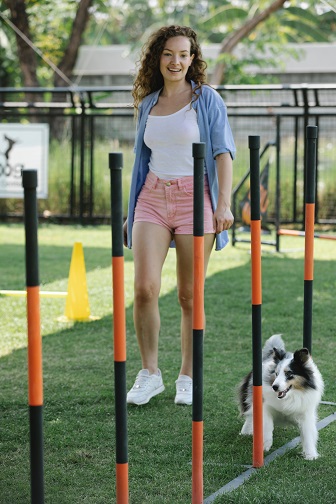Guide to Basic Obedience Training for Your Beloved Pet

Mypetpulse.com – Obedience Training
Welcoming a new furry friend into your home is an exciting and rewarding experience. As a responsible pet owner, it’s crucial to establish a foundation of obedience training to ensure a harmonious and well-behaved pet. In this guide, we’ll walk you through the step-by-step process of basic obedience training, equipping you with the knowledge and techniques to foster a strong bond and a well-mannered companion.
Contents:
Understanding the Importance of Basic Obedience Training
Essential Commands training: Sit, Stay, and Come
House Training: Establishing a Clean and Relaxed Environment
Troubleshooting Challenges and Maintaining Progress

Understanding the Importance of Basic Obedience Training
Before diving into the training process, let’s explore why basic obedience training is vital for your pet. Not only does it lay the groundwork for good behavior, but it also establishes clear lines of communication and trust between you and your furry companion. Through positive reinforcement techniques, time and practice, your furry friend will master these commands, making your interactions safer and more enjoyable for a lifetime of obedience and companionship.
Essential Commands training: Sit, Stay, and Come
Mastering essential commands like “Sit,” “Stay,” and “Come” is a key foundation in obedience training for your beloved pet. These commands not only help establish control and safety but also enhance communication and reinforce the bond between you and your furry companion.
- “Sit” Command:
Step 1: Start in a quiet, distraction-free environment. Hold a small treat close to your pet’s nose.
Step 2: Slowly move your hand up, allowing their head to follow the treat and naturally lowering their rear end into a sitting position.
Step 3: As soon as their bottom touches the ground, say “Sit” in a clear, firm voice and offer the treat as a reward. Step 4: Repeat this process multiple times, gradually phasing out the treat and relying on verbal praise and physical affection instead. Step 5: Introduce a hand gesture, such as raising your hand with an open palm, and practice the command in various settings to reinforce their understanding.
Remember to be patient, keep training sessions short and positive, and celebrate their successes with praise and rewards.
- “Stay” Command:
Step 1: Begin with your pet in the “Sit” position. With an open palm facing towards them, say “Stay” in a calm and assertive tone.
Step 2: Take a step back, keeping eye contact with your pet. If they remain in place, reward them with praise and a treat.
Step 3: Gradually increase the distance and duration of the “Stay” command, always returning to reward and praise your pet for successful stays. Step 4: Introduce distractions gradually, such as gentle movements or tempting toys, to test their impulse control and reinforce their ability to stay in place. Step 5: Use a release cue, like “Okay” or “Free,” to let your pet know they can move from the “Stay” position. Repeat this command in various environments to solidify their understanding.
Consistency, positive reinforcement, and gradually increasing difficulty will help your pet master the “Stay” command over time.
- “Come” Command
Step 1: Start in a quiet, enclosed area, with your pet on a leash or long training lead.
Step 2: Crouch down and enthusiastically call your pet’s name followed by the command “Come” while gently tugging the leash towards you.
Step 3: When they approach, reward them with praise and high-value treats or a favorite toy.
Step 4: Gradually increase the distance and distractions during training sessions, always rewarding successful recalls.
Step 5: Practice “Come” in various environments and situations, ensuring that your pet understands the command regardless of the circumstances.
Remember to maintain a positive and encouraging tone when using the “Come” command to foster a strong recall response in your pet.
House Training: Establishing a Clean and Relaxed Environment
House training is a crucial aspect of pet ownership, ensuring a clean and relaxed environment for both you and your furry friend. By establishing good toilet habits, you can create a harmonious living space and strengthen the bond with your pet.
- Establish a Designated Toilet Area: Choose a specific area in your home or yard where you want your pet to eliminate. Consistency is key, so stick to this designated spot throughout the training process. Take your pet to this area consistently after meals, playtime, waking up, and before bedtime.

- Create a Consistent Routine: Establish a regular feeding schedule to regulate your pet’s digestion and make potty times more predictable. Consistency helps your pet understand when it’s time to go outside. Take them to the designated toilet area at specific intervals throughout the day, gradually increasing the time between trips as they become more reliable.
- Supervision and Timing: When your pet is not confined to a crate or designated area, keep a close eye on them to prevent accidents. Watch for signs such as sniffing, circling, or restlessness, which indicate they need to eliminate. Immediately take them to the designated area when you notice these signs.
- Positive Reinforcement: Praise and reward your pet when they eliminate in the designated area. Use verbal cues such as “Go potty” or “Do your business” consistently to associate the cue with the desired behavior. Reward them with treats, praise, or playtime immediately after they finish eliminating in the correct spot. Positive reinforcement creates a positive association with the designated area and encourages them to repeat the behavior.
- Dealing with Accidents: Accidents are a normal part of the house training process. If you catch your pet in the act, interrupt them with a gentle sound and quickly take them to the designated area. Avoid scolding or punishing them, as it can create fear and hinder the training progress. Instead, thoroughly clean any accidents with an enzymatic cleaner to remove the scent, reducing the chances of repeat accidents in the same spot.
- Consistency and Patience: Consistency is vital during house training. Stick to the routine, praise and reward consistently, and maintain a positive attitude. Be patient with your pet as they learn and remember that every pet progresses at their own pace. Some may grasp house training quickly, while others may take more time. Stay committed and consistent, and soon your pet will develop good potty habits.
Troubleshooting Challenges and Maintaining Progress:
During the process of training your pet, you may encounter certain challenges that can impede their progress. However, with patience and the right approach, these challenges can be overcome. These are some of the most common hurdles in pet training and strategies for troubleshooting and maintaining progress.
- Handling Distractions: Pets can be easily distracted, especially during training sessions. If your pet is struggling to focus due to external stimuli or environmental factors, try the following:

- Gradual Exposure: Introduce distractions gradually, starting with mild ones and gradually increasing the level of difficulty. This helps your pet build resilience and focus.
- Reinforce Attention: Use high-value treats or rewards to capture and maintain your pet’s attention during training. This will help them associate focus and attentiveness with positive outcomes.
- Controlled Environment: Initially, conduct training sessions in a quiet and familiar space to minimize distractions. As your pet progresses, gradually transition to more challenging environments with controlled distractions.
- Overcoming Stubbornness or Resistance: Some pets may exhibit stubbornness or resistance during training, making it challenging to achieve desired behaviors. Here’s how you can address this:
- Patience and Persistence: Remain patient and persistent, as training requires time and repetition. Avoid becoming frustrated or resorting to punishment, as this can create a negative association with training.
- Break Tasks Down: If your pet is struggling with a specific command, break it down into smaller steps and reinforce each step individually. Gradually piece them together until your pet understands the complete behavior.
- Seek Professional Help: If you find yourself unable to make progress or facing persistent challenges, consider consulting a professional trainer or behaviorist. They can provide personalized guidance, tailored solutions, and additional support.
- Maintaining Consistency: Consistency is essential for successful training. Without it, your pet may become confused or struggle to retain what they’ve learned. Here’s how to maintain consistency:
- Stick to a Routine: Establish a consistent training schedule and follow it diligently. This helps your pet understand expectations and reinforces learned behaviors.
- Family Involvement: Ensure everyone in your household is on the same page when it comes to training. Consistency in commands, rewards, and expectations across all family members will prevent confusion for your pet.
- Regular Refreshers: Periodically revisit and reinforce previously learned commands or behaviors. This helps solidify their understanding and prevents regression.
If you encounter persistent difficulties or feel overwhelmed, seeking professional help can provide valuable guidance and support. Professional trainers or behaviorists have the expertise to address specific challenges and tailor training methods to your pet’s individual needs.
Conclusion
By following these steps, you will lay the foundation for a well-mannered pet and develop a strong bond built on trust and communication. Remember, patience, consistency, and the power of positive reinforcement will lead to enjoyable companionship and a rewarding journey as a responsible pet owner. Start your training adventure today and unlock the full potential of your beloved furry friend!



6 Comments
[…] Guide to Basic Obedience Training for Your Beloved Pet […]
Amazing article!
[…] Guide to Basic Obedience Training for Your Beloved Pet […]
[…] Guide to Basic Obedience Training for Your Beloved Pet […]
[…] |Also Read: Guide to Basic Obedience Training for Your Beloved Pet| […]
**cellufend**
cellufend is a natural supplement developed to support balanced blood sugar levels through a blend of botanical extracts and essential nutrients.